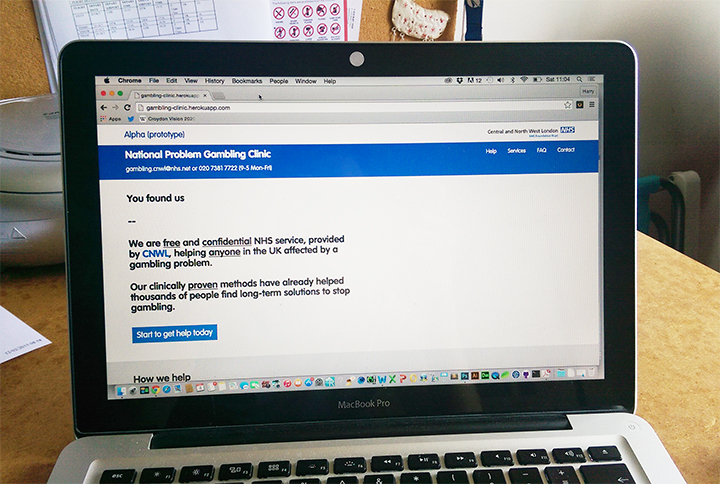Before joining GDS three months ago, I was studying service design at the Royal College of Art and doing service design in the National Problem Gambling Clinic: the only NHS service for people affected by gambling addiction.
Working at the clinic was nothing short of humbling, both in the users I met and the reality of trying to redesign services for them. I did end up building a thing: an asking-for-help service. At this time, I realised designing a service should always involve making it. All good saying this, so here is how I actually went about doing it:
1. Working in the service
For 9 months I was part of the clinic. Part of the team, delivering the service: therapy sessions in evenings, team meetings every Friday, manning reception. This was good for three reasons:
- discovering the user needs for myself
- understanding how the clinic works now
- gaining the team’s trust to let me design services
Spending this much time with users and the team, at the clinic, helped make clear where the most improvement could be made.
This isn’t the kind of thing you can learn by designing in a meeting or a far away office. You need to be in the service itself.
2. Get the basics right
Although the clinic is great at meeting its users’ complex, clinical needs, it sometimes finds it difficult to do seemingly basic things:
- information on what the service does
- making it easy to ask for help in the first place
- guidance on what users can do while waiting to talk in person with someone
One afternoon I covered reception for the clinic, I read emails and took phone calls. Lots of them. All from users. All saying the same things: ‘are your services free?’ ‘Are your services confidential?’ ‘Can anyone in the UK use your services?’ ‘How do I get help from you?’ Or simply ‘Help me.’
The clinic does have a website. It is the first part of the service users encounter. But it doesn’t meet users’ primary needs for information or to quickly ask for help. This is an issue, as analytics for the site later showed: while spending six and half minutes on average on the landing page, only 4% of users finding the site, end up asking the clinic for help. Given the site uses an application called Word-Bank to ‘explain difficult words’ and requires users to download a 5-page form to ask for help, the uptake rate starts to make sense.
Get the basics of a service working first. Otherwise services get hindered doing what they are good at and actually for. For the clinic, it was fixing the beginning of its service, as it was getting in the way of how it actually meets it's users' needs; talking face-to-face with them.
3. Service designers make things
During my time at the clinic, I started learning code. Still am. All designers should code. I wanted to make, not just design the things I saw user need for. Especially with the clinic, where the user need is so apparent. Honestly I could not reconcile myself to the prospect of designing a service which never got made: do something that didn’t make users lives easier.
As people say in GDS the strategy is delivery. At the clinic this had to be the same. That is what happened: through coding, testing and iteration, an asking-for-help service has been made. The service has:
- clearer information on what the clinic does
- online self-referral, which can be done quickly (7 minutes on average)
- guidance for users while they wait to talk face-to-face
As you will notice, the service is not finished. Nor should it ever be. The really exciting bit is soon the service will be available for users to start using and the clinic to get feedback on. Credit for which must go to the clinic team and the trust supporting them. Not to mentioned my ex-classmate Iban for getting the thing to work on the internet and not just on my computer.
How this compares to designing services at GDS
Since I’ve started at GDS I’ve noticed that the designers here don’t talk about service design: they talk about services. How to make them. How to make it easier for government to make them. This bias towards making is illustrated by ‘SHOW THE THING’ posters all round the office. The same strong bias I felt while at the gambling clinic, although I didn’t express it anywhere near as well. Building services that just work is the big ambition for designers in government.
Since being at GDS, I feel more confident of having a bias towards making. Making as a way to help set standards, explain a service pattern or test how a new service might work. Designing services involves making them. Service design results in services.

